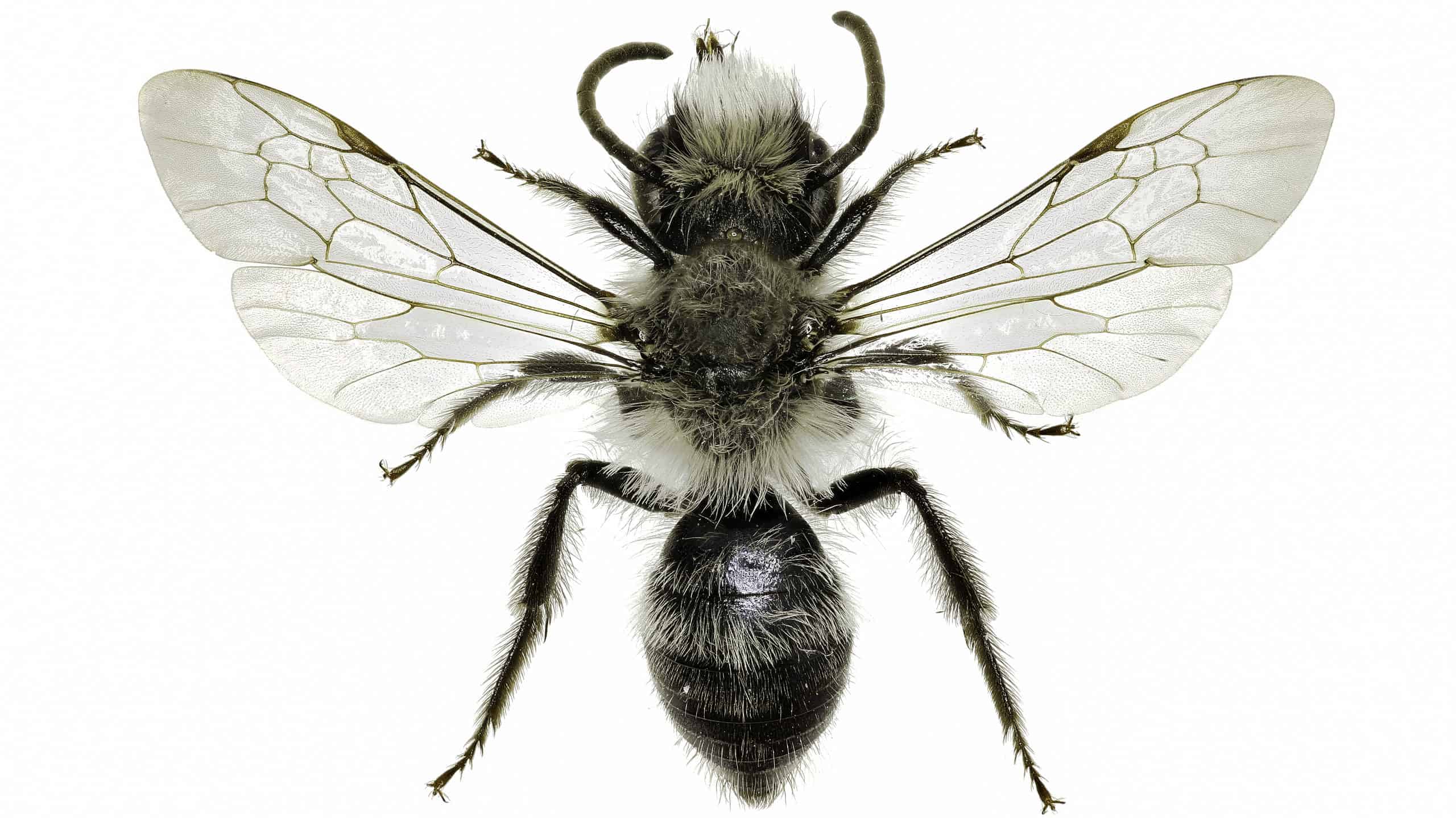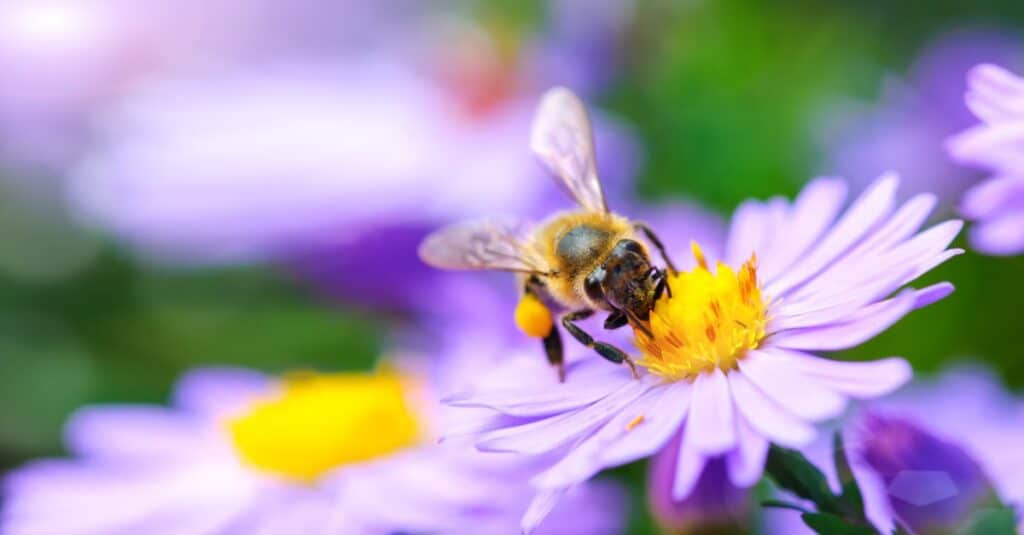Bee
Apis mellifera
Rock paintings of bees date back 15,000 years
Advertisement
Bee Scientific Classification
- Kingdom
- Animalia
- Phylum
- Arthropoda
- Class
- Insecta
- Order
- Hymenoptera
- Family
- Andrenidae
- Genus
- Apis
- Scientific Name
- Apis mellifera
Read our Complete Guide to Classification of Animals.
Bee Conservation Status
Bee Facts
- Name Of Young
- Larva, grub
- Group Behavior
- Solitary/Colony
- Fun Fact
- Rock paintings of bees date back 15,000 years
- Estimated Population Size
- at least two trillion
- Biggest Threat
- Disease, pesticides, habitat destruction
- Most Distinctive Feature
- Ability of some to make honey and beeswax
- Gestation Period
- three days
- Litter Size
- Six to 1000 per day
- Habitat
- Any habitat where there are flowering plants
- Predators
- Primates, wasps, dragonflies, birds, small mammals
- Diet
- Omnivore
- Type
- insect
- Common Name
- bee
- Location
- everywhere except Antarctica
“Bees are descended from predatory wasps, but they no longer prey on other insects.”
Any beekeeper knows that life on earth would be very difficult without these insects. Though not all provide honey, many of them are pollinators of plants that provide food for humans and other animals. As they move from flower to flower, build and maintain their nests and look after their young, bees are the epitome of industry and hard work. Yes, some of them sting, but it’s worth it. Read on for more about these amazing insects.
4 Incredible Bee Facts!
- The female Megachile pluto is about as long as a grown-up human thumb. She has huge jaws that she uses to collect resin for her nest.
- In general, the lifespan of a male bee is much shorter than that of a female. Females build nests, lay eggs, and raise the young, and even infertile honey bee females work themselves to death gathering pollen and maintaining their hive. Males have only one job, and in the case of the honey bee, he dies doing it.
- Even when the stinger of a honey bee is pulled out of her, muscles in the stinger both work it deeper into the skin and pump out more venom.
- They are haplodiploid, which means that females come from fertilized eggs and males come from unfertilized eggs.

Scientific Names
Bees are members of a clade called Anthophila. Anthophila is made up of the Greek words anthos, which means “flower” and phílos, which means “beloved.” So the word can be translated into “flower lover.” Besides this, there are 4,000 genera and 16,000 to 20,000 species of bee.
Evolution And Origin

Bees evolved from an ancient predatory wasp.
©gstalker/Shutterstock.com
Bees have an origin from 120 million years ago, during the Cretaceous Period, where they evolved from what was an ancient predatory wasp. Although, the bees that we know mostly feed on the pollen and nectar from flowers, their ancestors were carnivores and would sting other insects, paralyzing them, and bringing them back to their nests to feed. A fossil from over 100 million years ago, found in Myanmar, shows a transition from this hunter wasp to bees.
Types Of
There are over 20,000 different kinds of bees throughout the world with 4,000 of them being endemic to the United States. Bees are closely related to wasps and ants and are best known as a honey-producing species. Here are just a few of the bee species:
- Bumble Bee
- Honey Bee
- Carpenter Bee
- Perdita minima – known as the world’s smallest bee
- Franklin’s Bumblebee – the rarest bee in the world. Found only in southern Oregon and northern California.
- Mason Bee
- Leafcutter Bee
Appearance

©iStock.com/miroslavmisiura
These animals have the usual insect body plan. Their bodies are divided into a head, a thorax, and an abdomen. They have four thin, translucent wings and six legs and use their legs to build and dig, and some use their hind legs to carry pollen. They also have combs on their legs to help them clean their antennae. The insects have huge compound eyes and three tiny eyes called ocelli above them. Their antennae are segmented and branched. Bees also differ from other insects in that their bodies are plumper, as can be seen in the pleasingly fat bumblebee.
Bees can come in a great variety of patterns and colors and range in size from 2.36 inches in length to so small they can just be seen with the naked eye.
Behavior

Bees can be solitary or communal. The most famous of bees are the honey bees that live in hives, ruled by a queen.
©yod 67/Shutterstock.com
These insects can be solitary or communal. Honey bees famously live in hives dominated by a queen, who is the only female allowed to reproduce. The honey bee workers, who are her daughters, take care of her, her eggs, the larva, and pupae, and make sure that the hive is kept in good order. Honeybees also communicate where sources of nectar and pollen are located through the famous “waggle dance.” Workers also defend the hive, sometimes sacrificing their lives to do so. Males or drones are there to mate with the queen. They die soon after, and even if they don’t, they’re kicked out of the hive because they no longer serve a useful purpose.
Solitary bees don’t have this sort of communal structure. All the females in a solitary species can reproduce, and each one builds her own nest and forages to find pollen for her larvae. Because of this, they can be as good at pollination as honey bees, even as they don’t make honey or wax.
Some solitary bees appear to be social because they build their nests next to the nests of conspecifics. However, they don’t help each other build nests or raise their young, and their groups are called aggregations as opposed to colonies. Other solitary bees actually share a single nest, but each insect has its own cell.
Brood parasites often can’t collect their own pollen so they take over the nests of bees who do. They’ll lay their eggs there, and when the larva hatches it eats the pollen meant for the original larva. Most bees also fly during the day, though there are those that fly at dusk. These insects usually live in the tropics.
Habitat
Bees are found wherever there are flowering plants. Indeed, the two evolved together and influenced each other’s evolution.
Diet

The majority of bees live on a diet of pollen and nectar.
©Ed Phillips/Shutterstock.com
The great majority of bees have a diet of pollen and nectar. The few exceptions include the carrion or vulture bees from South America. They collect carrion, which they actually turn into a type of honey. Sweat bees also drink human sweat. Also, while many people believe bees like carpenter bees eat wood, the truth is they only bore into wood to store food and create nests for feeding larvae. Like other bees, carpenter bees eat nectar and pollen.
Predators And Threats

The greatest threat to bees is believed to be climate change, pollution and pesticides, to name a few.
©thatmacroguy/Shutterstock.com
These creatures have a great many predators and threats, as even the largest of them is a little insect, and some predators seem immune to stings. Predators include birds such as woodpeckers, flycatchers, and bee-eaters. Badgers and bears tear open the hives and eat the honey and the brood. Crab spiders and praying mantises ambush bees as they visit flowers. The Japanese giant hornet, nicknamed the “murder hornet” seems to like to catch honey bees and tear their heads off before eating them. People also eat bees, and brood is especially rich in nutrients.
But a greater threat to the insects, especially honey bees is a drastic population decline that scientists believe might be caused by pesticides, parasites, illness, climate change, pollution, or destruction of habitat. Colony collapse disorder is a strange phenomenon that happens when the workers in a hive simply disappear and actually abandon their queen. Scientists are not completely sure why this happens, but possible culprits are mites and pathogens.
Reproduction And Life Cycle

Bees will start looking for mates soon after they emerge from their pupae.
©HWall/Shutterstock.com
The insect’s reproductive life depends on whether it is solitary or communal. Bees start looking for mates very soon after they emerge from their pupae, and after mating the female builds a nest to begin her family. She will excavate cells in which to lay her eggs, and some such as leaf-cutter bees will line them with bits of leaf or flower petals. Nests might be underground or in wood. The queen honey bee lays her egg one by one in a honeycomb made of beeswax. After the first brood grows up, they’ll be the ones who make the honeycomb and take care of the brood. Other bees don’t bother to build their own nest but lay their eggs in the nest of another bee.
Population
The population of bees is about 2 trillion, but some species are in better shape than others. Apis mellifera, for example, is listed as Data Deficient, though it’s understood that its populations have declined.
What would happen if bees went extinct? You can find that in this article.
View all 285 animals that start with BBee FAQs (Frequently Asked Questions)
Are they dangerous?
Unfortunately, some people are allergic to stings, and their reaction to them can be life-threatening.
How many legs does a bee have?
Like most insects, a bee has six legs.
How do you identify them?
They are smallish insects with four transparent wings, antennae and bodies that are much more robust than those of wasps or ants. Many have striped abdomens or are furry, like bumblebees. You’ll often see them visiting flowers.
What do you do for a bee sting?
First, scrape it out with a fingernail or a stiff material such as a credit card. Pinching it only pumps more venom into the wound. Wash the area with soap and water then put a cold compress on it. For pain, redness or swelling take an NSAID or apply some hydrocortisone cream. If you are allergic, seek medical help immediately or use an epi-pen.
What does a bee sting look like?
If you were stung, the area will be a bit red, swollen, and itchy.
How many types of bees are there?
There are between 16,000 and 20,000 types of these mostly beneficial insects.
Is a bee good or bad?
Bees are very good indeed. Without them, much of human agriculture would not be possible. That’s why situations such as colony collapse are so alarming.
Can bees fart?
Yes, they do. When they eat, they digest their food much like humans. Air does enter the fecal matter and is passed as gas.
What are the types of bees?
Types include honey bees, bumblebees and leaf cutter, carrion, miner, sweat and carpenter bees.
What kind of bee doesn't sting?
Males of all species are stingless, and the females of 500 species are also stingless. Actually, they might possess stingers, but they’re fairly useless. Stingless bees belong to a tribe called Meliponini and are called meliponines. Beekeepers are becoming more and more interested in them because they are good pollinators and are completely harmless, even though some have a nasty bite.
Is honey just bee vomit?
Any beekeeper will tell you that honey is a bit more than bee vomit. The insects make honey by digesting and regurgitating nectar among themselves, then storing it in a honeycomb cell and making sure warm air circulates around it until some of the water evaporates. Then, when the insects are sure that the honey is not going to ferment or change into alcohol they seal the cell.
How many eyes does a bee have?
It has five eyes. It has two big compound eyes and three little eyes called ocelli.
What should you do if a bee lands on you?
If one lands on you, pretend to be a piece of furniture and simply study her quietly. Bees are not interested in humans, and they will fly away eventually.
How long do bees live?
Their lifespan depends on the species and the sex. A honey bee queen can live as long as five years, while a yellow-banded bumblebee worker lives as few as 13 days.
Is a bee sting more painful than a wasp sting?
Bees are painful, no doubt, but not when compared to common wasps, let alone wasps with famously painful stings
What is the difference between a beehive and a wasp nest?
The primary differences between a beehive and a wasp’s nest are their size and shape, colony size, and the production or storage of honey.
What is the difference between a bee and a hornet?
The main differences between hornets and bees include their appearances, where they live, behavior, diet, and their stings. While both have stingers, bees and hornets have many different features that set them apart. Bees are often considered beneficial to humans and the environment because they make honey and pollinate flowers. On the other hand, hornets are not associated with honey and are considered a nuisance.
Do bees poop?
Yes, bees poop. However, bee poop looks a lot different than human poop.
Thank you for reading! Have some feedback for us? Contact the AZ Animals editorial team.
Sources
- Wikipedia, Available here: https://en.wikipedia.org/wiki/Bee
- Veterinary Hub, Available here: https://veterinaryhub.com/male-honey-bee-dies-during-sex/
- BuzzAboutBees.net, Available here: https://www.buzzaboutbees.net/types-of-bees.html
- U.S. Forest Service, Available here: https://www.fs.fed.us/wildflowers/pollinators/pollinator-of-the-month/perdita_minima.shtml
- BBC News, Available here: https://www.bbc.com/news/science-environment-55006902
- dreamstime, Available here: https://www.dreamstime.com/larva-honey-bee-beehive-asia-larva-honey-bee-beehive-image112078044
- beehour.com, Available here: https://beehour.com/how-many-bees-are-left-in-the-world/
- IUCN, Available here: https://www.iucn.org/content/nearly-one-10-wild-bee-species-face-extinction-europe-while-status-more-half-remains-unknown-iucn-report
- Mayo Clinic, Available here: https://www.mayoclinic.org/diseases-conditions/bee-stings/diagnosis-treatment/drc-20353874
- rurallivingtoday.com, Available here: https://rurallivingtoday.com/homesteading-today/how-long-do-honey-bees-live/

















